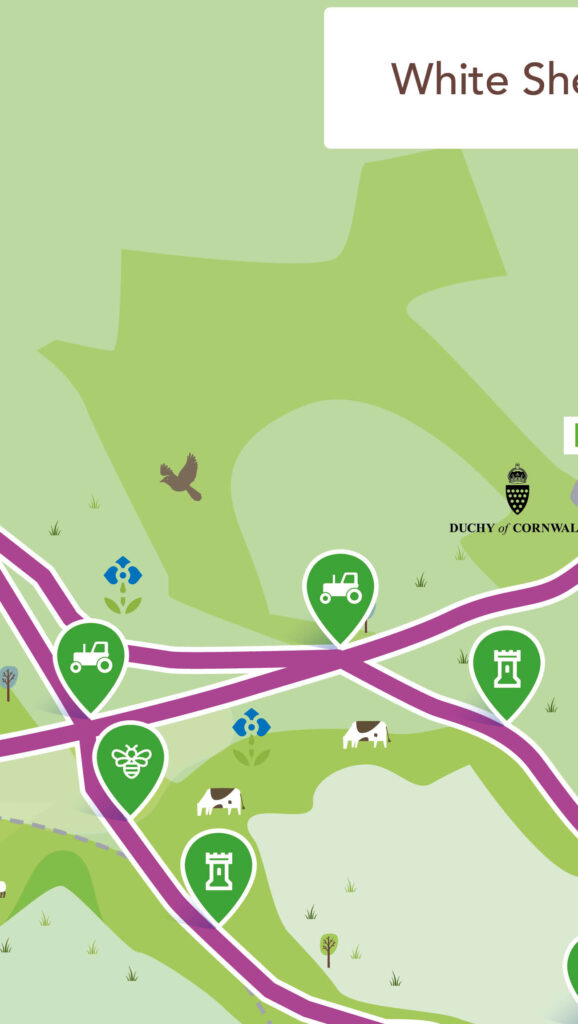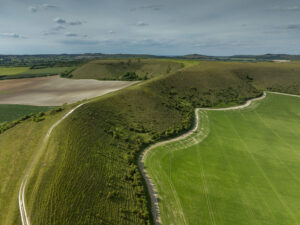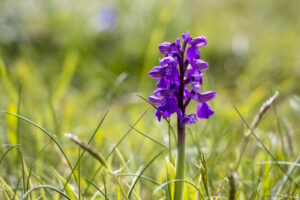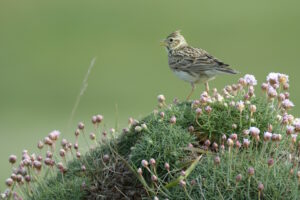
White Sheet Hill SSSI

View over the SSSI and the cross dyke – photo credit: Charles Sainsbury-Plaice
White Sheet Hill is a designated Site of Special Scientific Interest (SSSI). White Sheet comprises an extensive area of botanically rich chalk grassland on predominantly west-facing slopes and above these are areas of flatter more nutrient-rich grassland.
The site supports ‘nationally restricted’ species of animals and plants and is one of the most westerly areas of downland in Britain.
Grasses and Herbs
On the chalk slopes and earthwork banks, you will find grasses such as: sheep’s-fescue, meadow oatgrass, glaucous sedge and upright brome, together with abundant herbs including: salad burnet, cowslip, and mouse ear hawkweed.
Wild flowers
Growing with these is a wide range of species characteristic of a long period of uninterrupted management:
- Clustered bellflower
- Fragrant Orchid
- Frog Orchid
- Dwarf Sedge (nationally restricted)
- Burnt Orchid (nationally restricted)

Green Winged Orchid – photo credit: National Trust Images – Hugh Mothersol
Hawthorn scrub with occasional privet, hazel, ash, field maple and holly is scattered over parts of the down, creating a mosaic of habitats.The surrounding arable land helps to support wildlife, providing seeds and insects as food and a nesting habitat for ground nesting birds such as Skylarks and Lapwings.
Many of the fields have margins around them. These have been sown with mixes of grasses and wildflowers, providing pollen and nectar for pollinators, such as bees and butterflies and habitat ‘corridors’ across the landscape.
Invertebrates, insects and butterflies
Several nationally restricted invertebrates are found on the grassland including:
- Abida secale snail – a small, air-breathing land snail
- Bruchidius cisti – a species of leaf beetle
- Ceuthorhynchus terminates beetle
- Apion waltoni weevil
- You may also see the anthills of the yellow meadow ant (Lasius flavus).
Butterflies
There is a rich butterfly fauna with marsh fritillary, green hairstreak, grizzled skipper, chalkhill blue and the nationally restricted adonis blue, the food plant of which, the horseshoe vetch is widespread on the down.
Other animal species
Other animal species also make use of the downland and scrub, especially birds such as skylark, yellowhammer, green woodpecker and kestrel.

Skylark – photo credit: National Trust Images, Nick Upton
Field vole, rabbit and roe deer occur and there are at least two large active badger setts. Reptiles are represented by the common lizard.
History
History
The archaeological timeline here stretches between a Neolithic meeting place and a 1950s nuclear-fallout monitoring station. Spaced 500m apart along the crest of this curving hilltop are three ancient earthwork enclosures, each 200–300m in diameter.
The middle enclosure is the oldest, dated by excavation to over 5,600 years ago. Here, some of the earliest British farming families gathered, perhaps for ceremonies and to prepare their dead for burial. These sites are known as ‘causewayed enclosures’, because their boundaries were built as a series of ditches interrupted by gaps or causeways.
This site was later cut by a medieval cattle drove, still used as a routeway. Across this track to the north is a rare type of circular enclosure. It was probably built about 5,000 years ago, contemporary with the earthwork surrounding Stonehenge. Along the southern edge of the causewayed enclosure are four Bronze Age burial mounds, built 4,300–3,500 years ago.
The southern enclosure, on the far side of the hill, is an Iron Age hillfort, built on land already separated from the rest of White Sheet Hill by an earlier form of defence known as a ‘cross-ridge dyke’. These are typical of the Late Bronze Age, constructed 3,000–2,800 years ago. The hillfort was probably built about 2,500 years ago as a single rampart and ditch. Later, two more lines of defence were added to the north, where the ground is level and more vulnerable to attack. Traces of Iron Age round houses show that people once lived within the hillfort.
Countryside Code
Respect everyone
- Leave gates as you find them.
- Do not block access to gateways when parking.
- Be polite to others and share the space.
Protect the environment
- Take your litter away with you – this includes dog poo!
- Keep dogs under control and in sight.
- Care for nature and don’t cause any disturbance.
- Do not light fires or BBQs.